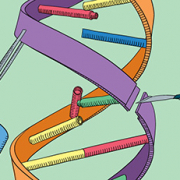Pharmacogenomics: mechanisms of action
We know that different people react differently to different drugs. But how does this actually happen? And where does genomics come in?
Pharmacogenomics – the study of the genomic determinants of drug response – is a catch-all term, but there are various different ways in which our biology can affect our body’s response to drugs. The two main interactions between drugs and the body are known as pharmacokinetics and pharmacodynamics, and both can be influenced by genomic factors.
Pharmacokinetics
Pharmacokinetic interactions are ones that affect how a drug is processed by the body: how it is absorbed, distributed, metabolised and excreted.
An individual’s genomics may impact the efficacy of a drug rather than what the drug will do in the body. For example, genomic alterations may determine the bioavailability (the amount of the drug available to the body) at target sites, and so have an impact on the appropriate dosing for that individual.
A good example is the cytokine CYP2D6, a protein which plays a role in the body’s metabolism of many drugs. Variations in the CYP2D6 gene determine whether an individual is a fast or slow metaboliser of certain medications. If an individual is a fast metaboliser of a CYP2D6-sensitive medication, the drug will usually be less effective because it is broken down and eliminated from the body more quickly. Slow metabolisers, conversely, may be more susceptible to side effects because the drug concentration builds up in the body.
Some medicines, known as prodrugs, must be altered in the body before they are effective. CYP2DX plays a role in activating some prodrugs – for instance codeine, which the body converts to morphine for pain relief. Slow metabolisers may not get effective pain relief from codeine, while ultra-rapid metabolisers have a higher risk of opioid toxicity because it is converted to morphine so efficiently.
Pharmacodynamics
Pharmacodynamics is concerned with the effect the drug has on the body – both the effect of the treatment and any side effects.
Pharmacodynamics can also be influenced by genomic factors; most notably, some gene variants are linked to an increased risk of serious adverse reactions.
Carbamazepine is a highly effective epilepsy drug, but a gene variant known as HLA-B*15:02 is associated with increased risk of severe hypersensitivity reactions, including the rarer but serious Stevens-Johnson syndrome and toxic epidermal necrosis, which can be fatal.
Screening for the variant is not a simple answer, as Professor Dyfrig Hughes from the Centre for Health Economics and Medicines Evaluation at Bangor University explained at May’s pharmacogenomics event. Professor Hughes suggested that if all patients with the gene variant were given an alternative medication, on average, for every hypersensitivity reaction avoided, three people would end up with uncontrolled epilepsy because the alternate drug is less effective. Thus, clinicians and patients still have to weigh up the risks carefully.
The double whammy
Some drugs are known to be affected by multiple genetic variants, some affecting pharmacodynamic interactions and others pharmacokinetic pathways.
A good example is Warfarin, which is known to be affected by variants at multiple locations in the genome – that is, variants in two different genes can influence the drug’s administration in different ways. Variations in one gene, CYP2C9, affect the metabolism of the drug (a pharmacokinetic effect); whereas variants in another gene, VKORC1, can affect the target of the drug – in this case a protein involved in blood clotting (a phamacodynamic variation).
Many of these variants are common: according to Professor Mark Caulfield from Genomics England, results taken from the 100,000 Genomes Project indicate that around 12.5% of people have the CYP2C9 genotype that would impact the appropriate dose of the drug.
If you are interested to hear more about pharmacogenomics and its place in the NHS, you can watch the discussions from our event in May here.
–









